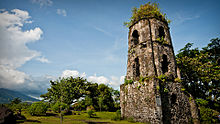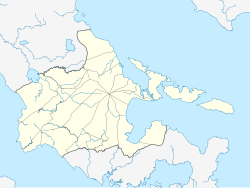
Albay, officially the Province of Albay, is a province in the Bicol Region of the Philippines, mostly on the southeastern part of the island of Luzon. Its capital is the city of Legazpi, the regional center of the whole Bicol Region, which is located in the southern foothill of Mayon Volcano.

Sorsogon, officially the Province of Sorsogon, is a province in the Philippines located in the Bicol Region. It is the southernmost province in the island of Luzon and is subdivided into fourteen municipalities (towns) and one city. Its capital is Sorsogon City and borders the province of Albay to the north.

The Bicol Region, designated as Region V, is an administrative region of the Philippines. It comprises six provinces, four on the Bicol Peninsula : Albay, Camarines Norte, Camarines Sur, and Sorsogon, and two off the shore: Catanduanes and Masbate.

Mayon, also known as Mount Mayon and Mayon Volcano is an active stratovolcano in the province of Albay in Bicol, Philippines. A popular tourist spot, it is renowned for its "perfect cone" because of its symmetric conical shape, and is regarded as sacred in Philippine mythology.

Legazpi, officially the City of Legazpi, is a component city and capital of the province of Albay, Philippines. According to the 2020 census, it has a population of 209,533. Legazpi is the regional center and largest city of the Bicol Region and in Albay, in terms of population. It is the region's center of tourism, education, health services, commerce and transportation in the Bicol Region. The city is applying for a Highly Urbanized City (HUC).
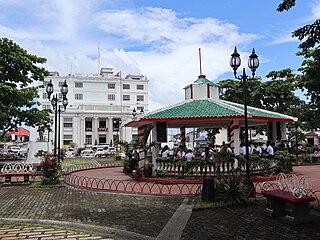
Tabaco, officially the City of Tabaco, is a component city in the province of Albay, Philippines. According to the 2020 census, it has a population of 140,961 people.

Guinobatan, officially the Municipality of Guinobatan, is a municipality in the province of Albay, Philippines. According to the 2020 census, it has a population of 85,786 people.

Typhoon Yunya, known in the Philippines as Typhoon Diding, was a strong tropical cyclone whose landfall in the Philippines coincided with the 1991 eruption of Mount Pinatubo. A small tropical cyclone, Yunya rapidly developed from a tropical disturbance near East Samar on June 11. By June 13 the storm had reached typhoon status as it moved west-northwest near the Philippines. Yunya attained its peak intensity the following day with estimated winds of 145 km/h (90 mph); however, strong wind shear soon impacted the typhoon and caused it to rapidly decay. The storm struck southern Luzon early on June 15 as a minimal typhoon before moving over the South China Sea later that day. After turning north and weakening to a tropical depression, the system brushed the southern tip of Taiwan on June 16 before dissipating the following day.

Daraga, officially the Municipality of Daraga, is a municipality in the province of Albay, Philippines. According to the 2020 census, it has a population of 133,893.

Mount Bulusan, also known as Bulusan Volcano, is a stratovolcano on the island of Luzon in the Philippines. Located in the province of Sorsogon in the Bicol Region, it is 70 kilometres (43 mi) southeast of Mayon Volcano and approximately 390 kilometres (240 mi) southeast of Manila. Bulusan is one of the active volcanoes in the Philippines.

Typhoon Durian, known in the Philippines as Super Typhoon Reming, was a deadly tropical cyclone that wreaked havoc in the Philippines and later crossed the Malay Peninsula in late November 2006, causing massive loss of life when mudflows from the Mayon Volcano buried many villages.
Widespread flooding occurred in the eastern part of the Philippines since late December 2010. The Visayas and the Bicol and Caraga regions have been particularly affected by abnormally heavy rains. The floods have displaced 452,999 persons in 19 provinces, and has caused the deaths of 25 people. By 12 January, the National Disaster Risk Reduction and Management Council (NDRRMC) pegged those affected at 235,867 families or 1,230,022 people in 1,267 villages in 137 towns and 10 cities in 23 provinces.

The Mayon Volcano Natural Park is a protected area of the Philippines located in the Bicol Region on southeast Luzon Island, the largest island of the country. The Natural park covers an area of 5,775.7 hectares, which includes its centerpiece Mayon Volcano, the most active volcano in the Philippines, and its adjacent surroundings. The volcano is also renowned for having an almost perfect cone. First protected as a National Park in 1938, it was reclassified as a Natural Park in the year 2000.

Legazpi station is the current railway terminus of the South Main Line located in Albay, Philippines. It is also the terminus for the Legaspi-Tabaco branch line. The station is currently used for the Bicol Commuter rail.
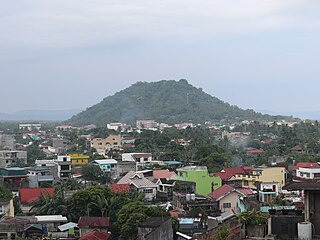
Ligñon Hill is a prominent hill in the city of Legazpi City, some 3 kilometers west of its downtown port area in Albay, Philippines. The summit rises to about 512 feet, affording excellent views of the Mayon Volcano to the northwest and the entire city and Albay Gulf to the east. The whole site is managed by the city and provincial government, and has been designated as a nature park.
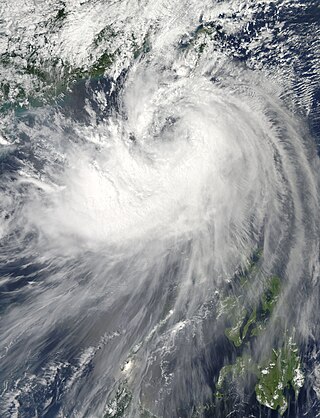
Tropical Storm Fung-wong, known in the Philippines as Tropical Storm Mario, was a relatively weak tropical cyclone which affected the northern Philippines, Taiwan and the Eastern China. The sixteenth named storm of the 2014 typhoon season, Fung-wong caused severe flooding in Luzon, especially Metro Manila.

Our Lady of the Gate Parish Church, also known as Nuestra Señora de la Porteria Parish Church and commonly known as Daraga Church, is a Roman Catholic church in the municipality of Daraga, Albay, Philippines under the jurisdiction of the Diocese of Legazpi. The church was built by the Franciscans in 1772 under the patronage of the Our Lady of the Gate. Certain church sections were declared as a National Cultural Treasure of the Philippines in 2007.

The archaeology of the Philippines is the study of past societies in the territory of the modern Republic of the Philippines, an island country in Southeast Asia, through material culture.

Typhoon Goni, known in the Philippines as Super Typhoon Rolly, was an extremely powerful tropical cyclone that made landfall as a Category 5 equivalent super typhoon on Catanduanes in the Philippines, and in Vietnam as a tropical storm. It is the strongest landfalling tropical cyclone on record by 1-minute maximum sustained winds. The name "Goni" means swan in Korean. The nineteenth named storm, ninth typhoon, and second super typhoon of the 2020 Pacific typhoon season, Goni originated as a tropical depression south portion of Guam on October 26. It was then named as Tropical Storm Goni on October 27. On the next day, Goni explosively intensified over the Philippine Sea, becoming a Category 5–equivalent super typhoon on October 30. Goni maintained Category 5 strength for over a day, before making landfall on Catanduanes at peak intensity, with 10-minute sustained winds of 220 km/h (140 mph), and 1-minute sustained winds of 315 km/h (195 mph), with a minimum central pressure of 905 hPa. It was the most intense tropical cyclone observed worldwide in 2020.
